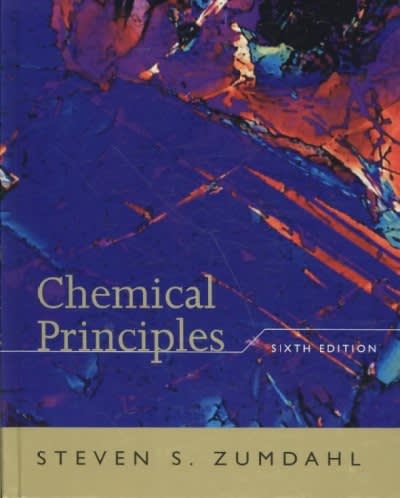Consider a solution formed by mixing (100.0 mathrm{~mL}) of (0.10 mathrm{M}) HA (left(K_{mathrm{a}}=1.0 times 10^{-6}ight), 100.0 mathrm{~mL})
Question:
Consider a solution formed by mixing \(100.0 \mathrm{~mL}\) of \(0.10 \mathrm{M}\) HA \(\left(K_{\mathrm{a}}=1.0 \times 10^{-6}ight), 100.0 \mathrm{~mL}\) of \(0.10 \mathrm{M} \mathrm{NaA}\), and \(100.0 \mathrm{~mL}\) of \(0.05 \mathrm{M} \mathrm{HCl}\). In calculating the \(\mathrm{pH}\) for the final solution, you would make some assumptions about the order in which various reactions occur to simplify the calculations. State these assumptions. Does it matter whether the reactions actually occur in the assumed order? Relate this to Question 8.
Explain.
Data from Question 8
Consider a solution prepared by mixing equal moles of a weak acid \(\mathrm{HA}, \mathrm{HCl}\), and \(\mathrm{NaA}\). Which of the following best describes what happens?
The \(\mathrm{H}^{+}\)from the \(\mathrm{HCl}\) reacts completely with the \(\mathrm{A}^{-}\) from the \(\mathrm{NaA}\). Then the HA dissociates to some extent.
The \(\mathrm{H}^{+}\)from the \(\mathrm{HCl}\) reacts with the \(\mathrm{A}^{-}\)from the \(\mathrm{NaA}\) to make \(\mathrm{HA}\), whereas the HA is dissociating. Eventually you have equal amounts of everything.
The \(\mathrm{H}^{+}\)from the \(\mathrm{HCl}\) reacts with the \(\mathrm{A}^{-}\)from the \(\mathrm{NaA}\) to make \(\mathrm{HA}\), whereas the HA is dissociating. Eventually all the reactions have equal rates.
The \(\mathrm{H}^{+}\)from the \(\mathrm{HCl}\) reacts completely with the \(\mathrm{A}^{-}\) from the NaA. Then the HA dissociates until "too much" \(\mathrm{H}^{+}\)and \(\mathrm{A}^{-}\)are formed, so the \(\mathrm{H}^{+}\)and \(\mathrm{A}^{-}\) react to form HA, and so on. Eventually equilibrium is reached.
Step by Step Answer:






